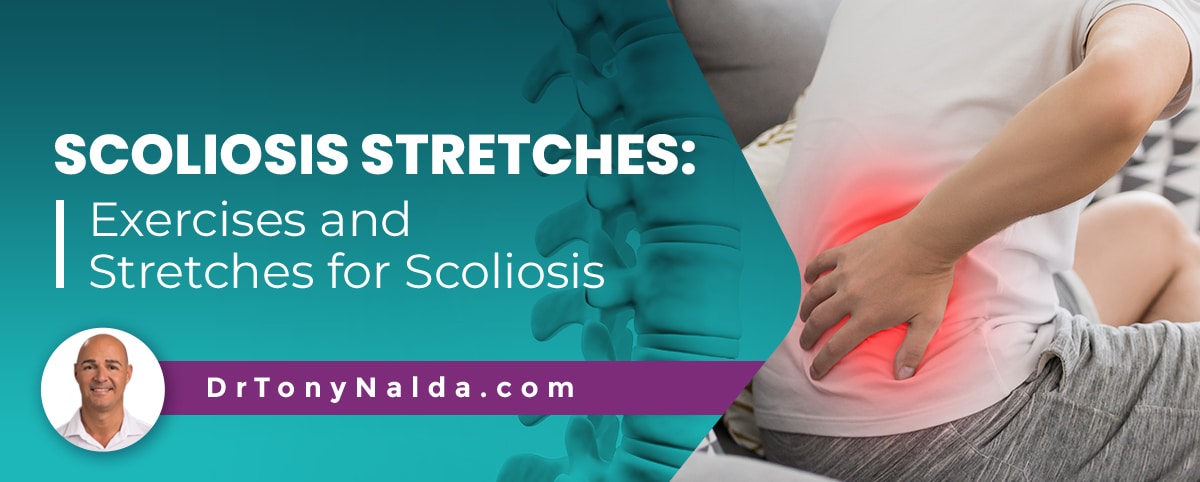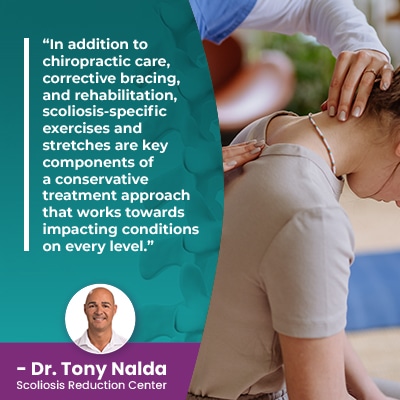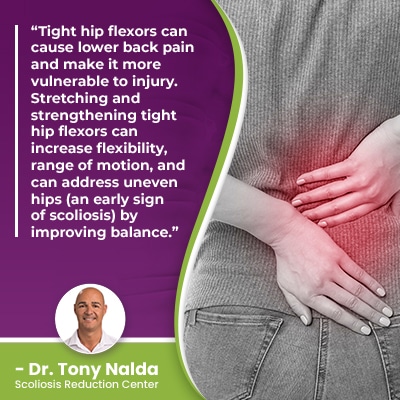Scoliosis Stretches: Exercises and Stretches for Scoliosis

While no type of exercise should be attempted without first being cleared by a patient’s scoliosis-treatment provider, when performed as prescribed, scoliosis-specific exercises and stretches can be an important facet of treatment. Continue reading to learn more about the place of exercise in scoliosis treatment.
When scoliosis-specific exercises and stretches are integrated into a proactive chiropractic-centered treatment plan, they can help make the spine stronger and more flexible, and can strengthen surrounding muscles for optimal spinal support.
Before getting to the specifics of how exercises and stretches for scoliosis can help, let’s first address how scoliosis is diagnosed, and how it affects the spine and body.
Table of Contents
Diagnosing Scoliosis
Diagnosing scoliosis means an unnatural spinal curve with rotation has developed, and this introduces a lot of uneven forces to the spine, its surrounding muscles and nerves, and the entire body.
The rotational component is what makes scoliosis a complex 3-dimensional condition because a scoliotic spine doesn't just bend unnaturally, but also twists from front to back, back to front.
When the spine is straight and aligned as it should be, the body’s center of gravity is in place, but when the spine develops an unnatural curve, it’s no longer aligned, and this shifts the body’s center of gravity and can disrupt a person’s balance, coordination, and gait.
Additional changes to watch for are uneven shoulders, hips, and the development of a rib arch, as these types of postural changes are caused by the condition’s introduction of uneven forces and how they disrupt the body’s overall symmetry.
Being diagnosed with scoliosis also means living with a progressive condition whose nature is to get worse over time, so where a scoliosis is at the time of diagnosis doesn't mean that’s where it will stay, especially without treatment.
Scoliosis ranges widely in severity from mild to moderate and severe to very severe, and this is determined by a measurement known as Cobb angle:
- Mild scoliosis: Cobb angle measurement of between 10 and 25 degrees
- Moderate scoliosis: Cobb angle measurement of between 25 and 40 degrees
- Severe scoliosis: Cobb angle measurement of 40+ degrees
- Very-severe scoliosis: Cobb angle measurement of 80+ degrees
When it comes to treating scoliosis, there are two main ways to respond: surgically or non-surgically.
Scoliosis Treatment Options
While there are never treatment guarantees, when detected early and responded to with treatment started early in a condotiom’s progressive line, there are fewer limits to what can be achieved, and one of my goals of treatment is to help patients avoid the hardships associated with progression and the need for invasive surgical treatment in the future.
There was a time when the place of exercise in scoliosis treatment was questioned, but we’ve since learned enough about the condition to know that scoliosis-specific exercise can improve treatment efficacy.
As scoliosis progresses, the size of the unnatural spinal curve is increasing, as are the condition’s uneven forces, and their effects.
In children, the main scoliosis effect is postural deviation, and in adults, it’s pain, and this is because scoliosis doesn't become a compressive condition until skeletal maturity has been reached.
Prior to reaching skeletal maturity, a growing spine is experiencing a constant lengthening motion that counteracts the compressive force of the unnatural spinal curve, and it’s compression of the spine and its surrounding muscles and nerves that causes the majority of condition-related pain.
As scoliosis progresses, the spine gets increasingly rigid, and this can make the spine less responsive to treatment, and in addition, increasing spinal rigidity can make it difficult for some patients to perform certain therapeutic exercises and stretches that are part of treatment.
When it comes to exercises and stretches, when they are scoliosis-specific and approved as part of treatment, they can help keep the spine strong and flexible, making it more responsive to chiropractic care, which is the most important facet of treatment because it impacts the condition’s underlying structural nature.
In addition, exercises and stretches can help keep the spine’s surrounding muscles strong, and this is important because they provide the spine with support, so stronger surrounding muscles means more support/stabilization.
And let’s not forget the mental-health benefits of exercise, and a good attitude is key to committing to, and handling, the challenges of treatment.
Now that we’ve defined the condition, and discussed, in general, how scoliosis-specific exercises and stretches can help, let’s explore some specific exercises and stretches that can augment corrective treatment results.
Scoliosis-Specific Exercises and Stretches
 In addition to chiropractic care, corrective bracing, and rehabilitation, scoliosis-specific exercises and stretches are key components of a conservative treatment approach that works towards impacting conditions on every level.
In addition to chiropractic care, corrective bracing, and rehabilitation, scoliosis-specific exercises and stretches are key components of a conservative treatment approach that works towards impacting conditions on every level.
Chiropractic care includes a series of techniques and adjustments that work towards adjusting the position of the curve’s most-tilted vertebrae back into alignment with the rest of the spine, and exercises and stretches are part of physical therapy.
Once I start to see chiropractic care impact the condition’s underlying structural nature, physical therapy is applied in an effort to strengthen the spine’s surrounding muscles so they can optimally support it.
Following are some exercises and stretches for scoliosis that can help facilitate treatment success, and in addition, for those dealing with scoliosis pain, exercises and stretches can provide pain relief caused by spinal rigidity and stiff, sore, and unbalanced muscles.
Scoliosis can cause painful muscle imbalances as the unnatural spinal curve pulls its surrounding muscles in different directions, making muscles on one side stretched and loose from overuse, and muscles on the other side can become weak from underuse.
Flexion and extension exercises: the flexor muscles facilitate bending motions, and the extensor muscles assist with straightening and/or extending.
When the flexor and extensor muscles are balanced, the spine’s supportive muscles are loose, strong, balanced, and facilitate the smooth gliding motion of the spinal joints during activity.
Cervical flexion and extension exercise and lumbar extension exercise can help keep the spine’s surrounding muscles balanced, and this helps keep the spine aligned and able to maintain its natural curves.
Chest expander exercise: the chest expander exercise targets the thoracic spine, which as the largest spinal section (middle/upper back) is the most commonly affected by scoliosis.
 Performing the chest expander exercise regularly and as part of treatment promotes a healthy thoracic curve by stretching the rhomboid muscles and creating space within the chest.
Performing the chest expander exercise regularly and as part of treatment promotes a healthy thoracic curve by stretching the rhomboid muscles and creating space within the chest.
While lung impairment isn’t a common complication of scoliosis and is more so associated with very-severe types, the development of a rib arch is common and this can also cause chest pain, and ensuring that the chest is open and flexible can help prevent related breathing issues and chest pain.
Seated butterfly stretch: the seated butterfly stretch targets the hips and pelvis and is a type of hip-flexion exercise.
The hips help provide balance and facilitate good posture; the hip flexors use numerous muscles that impact the lower body’s range of motion.
Tight hip flexors can cause lower back pain and make it more vulnerable to injury. Stretching and strengthening tight hip flexors can increase flexibility, range of motion, and can address uneven hips (an early sign of scoliosis) by improving balance.
Exercises and stretches to avoid with scoliosis: exercises and stretches to avoid with scoliosis are those that place the spine in unnatural positions, involve overusing one side of the body, hyperextending the spine, and/or repeatedly expose the spine to stress from impact.
Conclusion
Scoliosis is a highly-variable progressive spinal condition that ranges from mild to very severe, affects all ages, and has different condition types with unique characteristics and treatment needs.
The complex nature of the condition necessitates the customization of potentially-effective treatment plans, and this is because no two cases are the same.
Exercises and stretches that can be helpful for one patient might not be helpful for another, and what’s deemed safe for one can be deemed unsafe for another’s curvature type, which is why no form of exercise or stretching should be attempted without prior approval from a patient’s scoliosis-treatment provider.
While exercises and stretching can be beneficial for scoliosis patients, some should be approached with caution, while others should be avoided entirely.
When it comes to exercises and stretches for scoliosis that are scoliosis-specific and integrated into a customized conservative treatment plan by a scoliosis specialist, they can help facilitate corrective results by keeping the spine strong and flexible, as well as its surrounding muscles for support and stabilization.
Heart at the Scoliosis Reduction Center, I’ve been treating scoliosis non-surgically for over 20 years, and the Center’s results speak for themselves.
Through integrating condition-specific chiropractic care, physical therapy, corrective bracing, and rehabilitation, I can impact conditions on every level for long-term sustainable treatment results.
Dr. Tony Nalda
DOCTOR OF CHIROPRACTIC
After receiving an undergraduate degree in psychology and his Doctorate of Chiropractic from Life University, Dr. Nalda settled in Celebration, Florida and proceeded to build one of Central Florida’s most successful chiropractic clinics.
His experience with patients suffering from scoliosis, and the confusion and frustration they faced, led him to seek a specialty in scoliosis care. In 2006 he completed his Intensive Care Certification from CLEAR Institute, a leading scoliosis educational and certification center.
About Dr. Tony Nalda
 Ready to explore scoliosis treatment? Contact Us Now
Ready to explore scoliosis treatment? Contact Us Now





